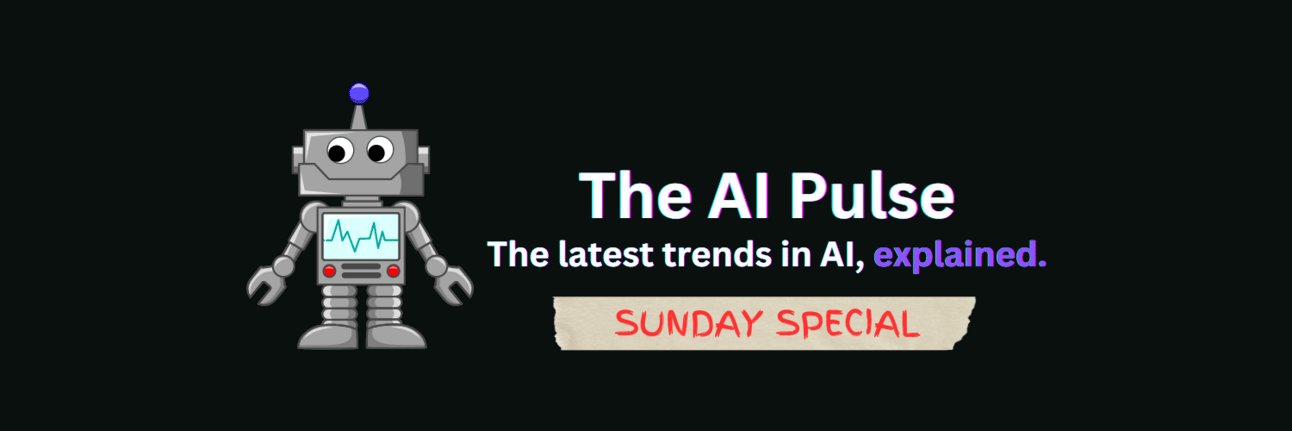
Welcome back AI prodigies!
In today’s Sunday Special:
🐝Just a Buzzword?
💭“AI-Powered,” Demystified
💨Is Faster Always Better?
🔑Key Takeaway
Read Time: 6 minutes
🎓Key Terms
Application Programming Interface (API): a tool that allows multiple software applications to rapidly share data, features, and functionality back-and-forth.
Dot-Com Bubble: a rapid rise in U.S. technology stock equity valuations fueled by investments in internet-based companies in the late 1990s.
If Statement: a conditional statement that controls the flow of your code. It allows you to execute a block of code if a certain condition is met.
🩺 PULSE CHECK
Are existing products being rebranded as “AI-powered” to boost sales?
🐝JUST A BUZZWORD?
If you search for an AI-powered product on Google, you’ll probably find one. A $74.99 headset sold last year as a regular headset is now a pair of advanced “AI Noise Cancelling” headphones. As a customer, how would you know the difference? How do you know all the Silicon Valley billboards touting AI tools are AI tools? Most of us don’t. Just like during the Dot-Com Bubble, nobody knew the value of the internet; we’re just as clueless about the actual value of AI decades later. With that, we’ve possibly nearly reached the peak of the AI hype cycle. There’s no better physical proof than Humane’s Ai Pin and Rabbit’s R1.
Both were among the most embarrassing hardware-software integration flops in recent technology history, worse than Hyperloop One, Google’s Project Ara, or Apple’s butterfly keyboard design. It’s no use airing grievances about Humane and Rabbit products; technology reviewers Marques Brownlee (MKBHD) and Dave2D have already done a decent enough job. They’re both far from production-ready and should’ve never seen the light of day. The more concerning reality, however, is that these two devices aren’t the only AI devices that should’ve been left on a napkin doodle.
At this stage, if statements and decades-old algorithms could have performed just as effectively with a human expert as some of these self-proclaimed “AI” tools. While that sounds ridiculous, two investment advisory firms, Delphia Inc. and Global Predictions Inc., did precisely that. They made false and misleading statements about the capabilities of their data tools, claiming AI was running in the background. However, the data tools didn’t leverage AI frameworks to analyze and synthesize data for retail clients; instead, they relied on manual analysis and traditional algorithms. In proprietary, closed-source code, the public needs more insight into what’s happening behind the user interface, whether hardware or software. False advertising, gray areas, and marketing talk have always been an “open secret” of sorts. On paper, most products look spectacular. Every piece of software advertises solving the problem faster and better, even the problems you never knew you had. Adding AI into the mix is just another flavor of that “sales pitch,” except now it’s called “AI washing.”
How do you know whether AI powers an application or a series of if statements, browser APIs, and algorithms do? Believe it or not, browser APIs can execute speech recognition and speech synthesis. Put in a crude way, an algorithm is still nothing but a loop of conditional statements. Many marketers today slap an AI label on anything that charges. But should you, and when you do, what does that mean to the end user? Well, that depends on what the “AI” label means.
💭“AI-POWERED,” DEMYSTIFIED
When products begin to appear that do everything we already have devices and apps for, just worse, that’s the pinnacle of utter futility. Rabbit’s R1 and Humane’s Ai Pin represent most so-called “AI” products today. If you’ve seen these devices work, you already know how slow and clunky they can be. They all suffer from the same shortcoming: slowness. Ask Humane’s Ai Pin about tomorrow’s weather, and it’ll take 20 to 30 seconds to offer a basic answer to something that even Siri would have provided within just 1 second, and we all know Siri wins no awards. Compared to the worst home assistants, “AI” still delivers answers 10 to 30 times slower, so why use “AI?” Because it sells.
Most “AI” features will be slow, and replacing an existing capability with AI will only degrade the user experience. What if that personal assistant voice sounds a tiny bit robotic? That’s far better than a perfectly synthesized Morgan Freeman replying 20 to 30 seconds too late.
Here are the three main reasons why Humane’s Ai Pin is slow to answer simple questions:
Limited Processing Power: The Ai Pin runs locally on Qualcomm’s Snapdragon 720G processor for images and voice processing.
Needing to Access the Cloud: The Ai Pin relies on cloud-based processing for text-to-speech features as well as search and information retrieval. The device must send your questions to a remote server and retrieve and return the answer. This back-and-forth can add delay.
Generating the Response: The Ai Pin must craft clear and concise answers to questions. This process involves selecting information, phasing it correctly, and using an interface (e.g., lights and voice) to deliver it. For example, asking, “What’s the weather like today?” requires the device to access external data and leverage an internal knowledge base to determine location, temperature, and context.
Humane’s Ai Pin leveraged the AI hype cycle to release the first AI wearable device, only for users to receive an unreliable and slow mini-projector with a short battery life that overheats.
💨IS FASTER ALWAYS BETTER?
Now, the question is, after all that waiting, do you get something beneficial, or could you have done it just as well without AI? More often than not, it fails to live up to expectations. Take a look at LinkedIn’s AI feature. Why would anyone need to generate a post instead of writing it? What was wrong with writing it in the first place? People come to LinkedIn to connect with other human professionals, not robots.
Some AI integrations improve tools by streamlining repetitive and manual tasks and reducing the skill barrier to accomplishing goals. For example, the Pixelmator Pro photo editor, which doesn’t connect to third-party services, offers AI-enabled gradient, color, and brush selections that reduce the editing process and make it easier to enhance photos.
However, other tools that rely on generative AI applications from third-party services such as OpenAI, Hugging Face, or Microsoft Azure to add AI options create more trade-offs.
While one could argue for these trade-offs, AI advancements seem to provide a “more stuff in less time” type of benefit. In the case of third-party AI APIs, some of these benefits get canceled out by repeated wait times, potential hallucinations, and multiple tries to achieve the desired result. On-device AI is also error-prone, but at least it’s faster.
🔑KEY TAKEAWAY
Many products marketed as “AI-powered” are leveraging the surging interest in AI advancements for sales to boost their bottom line. These “AI-enabled” products are often slow, clunky, and worse at tasks than existing solutions. Be wary of AI buzzwords and focus on whether the product actually solves a problem in a helpful way. Does it make tasks faster, more efficient, or offer unique insights?
📒FINAL NOTE
If you found this useful, follow us on Twitter or provide honest feedback below. It helps us improve our content.
How was today’s newsletter?
❤️TAIP Review of the Week
“Another Sunday, another Sunday Special! What’s your opinion on startups rebranding to be AI-centric?”
REFER & EARN
🎉Your Friends Learn, You Earn!
{{rp_personalized_text}}
Refer 9 friends to enter 🎰May’s $200 Gift Card Giveaway.
Copy and paste this link to others: {{rp_refer_url}}
